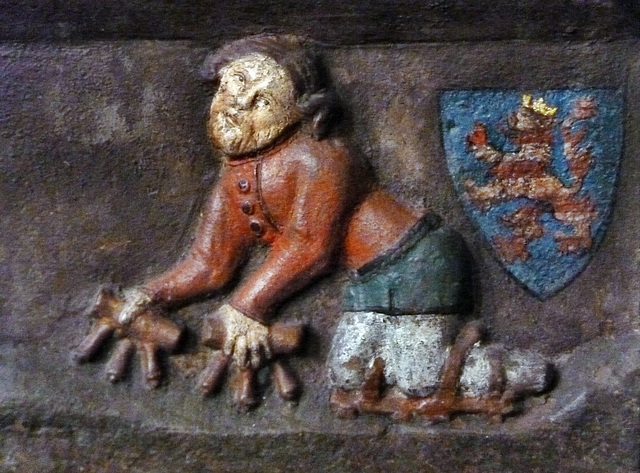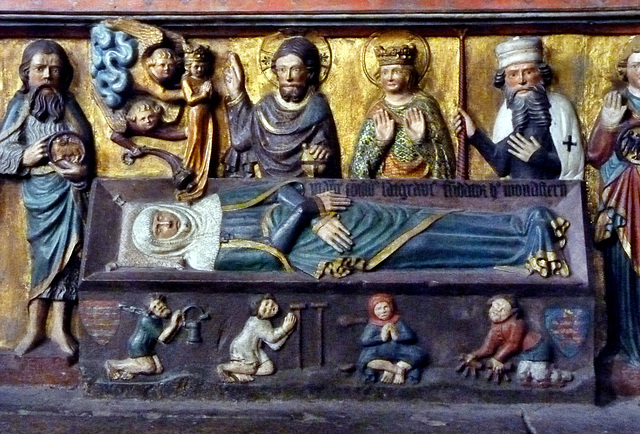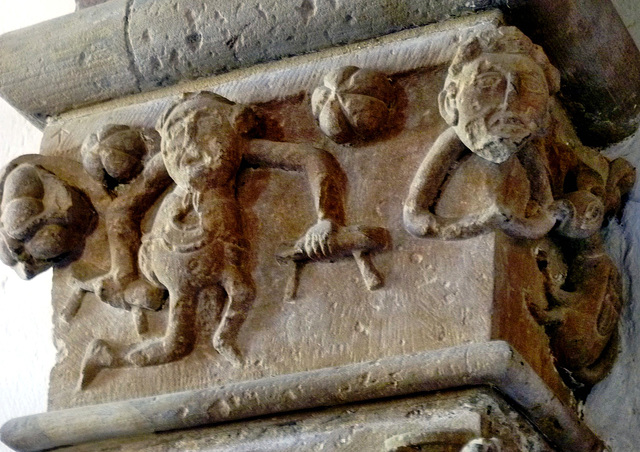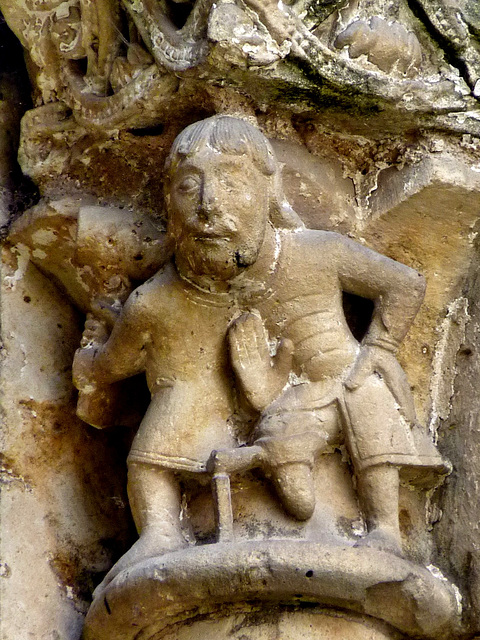
Medieval crutches and prostheses
Marburg - Elisabethkirche
Marburg developed at the crossroads of two important medieval routes. The settlement was protected by a small castle built during the ninth or tenth century. Since 1140 Marburg has been a town, owned by the Landgraves of Thuringia, residing on the Wartburg above Eisenach.
In 1228, the widowed Elizabeth of Hungary (aka Elizabeth of Thuringia), chose Marburg as her dowager seat. The countess dedicated her life to the sick and would become after her early death in 1231, aged 24, one of the most prominent female saints of the era. She was canonized already in 1235.
Marburg was a provincial town in Hesse, known for the University, the oldest Protestant-founded university in the world, founded in 1527. In 1529, Philipp I of Hesse arranged the "Marburg Colloquy", to propitiate Martin Luther and Huldrych Zwingli.
St. Elisabeth had founded a hospital here in 1228, where she cared for sick and needy people until her death. She was buried in the hospital chapel. Immediately began a pilgrim's stream and numerous miracles of healing were witnessed.
In honour of St. Elizabeth the Elisabethkirche ("St. Elizabeth's Church") was built by the Order of the Teutonic Knights. The church is one of the earliest purely Gothic churches in German-speaking areas, and is held to be a model for the architecture of Cologne Cathedral. The church was consecrated in 1283. The work on the two towers continued until 1340.
In 1539, Landgrave Philip had the bones of St. Elizabeth removed to set a mark against the cult of the relics, almost all of the formerly Catholic friars converted to Protestantism. Part of the originally rich figure jewelry got removed.
In the left transept was the grave of St. Elizabeth over which this mausoleum was erected, a canopy over the coffin, that stood here until 1249.
What happened just after (or even shortly before) St. Elisabeth died, just 25 years old, is a cruel story. As she was venerated as a saint already during her lifetime, pious people (and relic merchants) are said to have literally pounced on the corpse. They tore pieces from their shroud, cutting off nails, hair and even her ears. Then the corpse was "officialy" cut in pieces, flesh and boned got separated, put into reliquaries and stored in the coffin.
St. Elizabeth´s deathbed is depicted on the front of the mausoleum. Two angels carry the soul up, where God and saints are already waiting for her. Below her deathbed are four mourning persons. Here is one if them: a crippled man, moving on crutches. This typ of crutches was widely used by lame persons in medieval times, see PiP.
Marburg - Elisabethkirche
Marburg developed at the crossroads of two important medieval routes. The settlement was protected by a small castle built during the ninth or tenth century. Since 1140 Marburg has been a town, owned by the Landgraves of Thuringia, residing on the Wartburg above Eisenach.
In 1228, the widowed Elizabeth of Hungary (aka Elizabeth of Thuringia), chose Marburg as her dowager seat. The countess dedicated her life to the sick and would become after her early death in 1231, aged 24, one of the most prominent female saints of the era. She was canonized already in 1235.
Marburg was a provincial town in Hesse, known for the University, the oldest Protestant-founded university in the world, founded in 1527. In 1529, Philipp I of Hesse arranged the "Marburg Colloquy", to propitiate Martin Luther and Huldrych Zwingli.
St. Elisabeth had founded a hospital here in 1228, where she cared for sick and needy people until her death. She was buried in the hospital chapel. Immediately began a pilgrim's stream and numerous miracles of healing were witnessed.
In honour of St. Elizabeth the Elisabethkirche ("St. Elizabeth's Church") was built by the Order of the Teutonic Knights. The church is one of the earliest purely Gothic churches in German-speaking areas, and is held to be a model for the architecture of Cologne Cathedral. The church was consecrated in 1283. The work on the two towers continued until 1340.
In 1539, Landgrave Philip had the bones of St. Elizabeth removed to set a mark against the cult of the relics, almost all of the formerly Catholic friars converted to Protestantism. Part of the originally rich figure jewelry got removed.
In the left transept was the grave of St. Elizabeth over which this mausoleum was erected, a canopy over the coffin, that stood here until 1249.
What happened just after (or even shortly before) St. Elisabeth died, just 25 years old, is a cruel story. As she was venerated as a saint already during her lifetime, pious people (and relic merchants) are said to have literally pounced on the corpse. They tore pieces from their shroud, cutting off nails, hair and even her ears. Then the corpse was "officialy" cut in pieces, flesh and boned got seperated, put into reliquaries and stored in the coffin.
St. Elizabeth´s deathbed is depicted on the front of the mausoleum. Two angels carry the soul up, where God and saints are already waiting for her. Below her deathbed are four mourning persons. Below her deathbed are four mourning persons: a man in chains, a poor beggar and two cripples with their crutches.
Fritzlar - St. Peter
St. Peter (aka "Fritzlarer Dom") is tightly connected to Saint Bonifatius. the most important christian missionary in the east of the Frankish Kingdom, preaching the gospel to the germanic tribes.
The "Vita sancti Bonifati", written only some decades after his martyrdom in 755, tells, that Saint Bonitatius came to this place and chopped down a sacred oak, dedicated to the pagan god Thor (Donar). All onlookers were waiting for Thor´s fierce reaction, but Thor did not care. After the felling Saint Bonifatius used the timber - and had a wooden church built here. There is a statue in front of the church, that shows Bonifatius standing on the stub of a oak, holding a huge axe. He founded a monastery nearby and named Saint Wigbert the first abbot. Saint Wigbert replaced the humble wooden structure by a prestigious stone one. This was probably the church that archeologists found traces of. It dates back to the end of the 8th century. Times were hard, in 774 pagan Saxons destroyed the abbey, but the stone church (23 meters.long), obviously withstook the attacs.
But the Saxons returned in 1079 - and this time, they looted and destroyed the abbey, the church and the settlement. The building of a three nave, flat roofed basilica started 1085/1090 and was completed in 1118. It was an impressing large church with an extensive westwork, but already in 1171 the visiting Archbishop found the structure in such a bad state, the he commisioned a "rebuilding", what, as the romanesque style had changed created a "new church".
Nowadays many architectural styles can be found here, as architects and builders were busy all the time.
Here another capital from the interior of the narthex ("Paradies), that was added before between 1253 -1267. This hall was used as a chapel and as a law court in that times.
When I saw this capital (and took the photo) I "underestimated" it. I just saw a strange figure, damaged edges. I did not take a closer look or take more photos. Meanwhile I tried to find information about this carving, but Gottfried Kiesow does not even mention these capitals in his book "Romanik in Hessen".
The artistic style differs clearly from that elaborate carving of the capital just seen. In the center is a cripple with a huge head and a short round body. He has one long and one short leg. His arms are (compared to the body) way too long and his hands hold wooden blocks, that he uses to move. Around his neck is a kind of bag.
One the right edge a large head - and two thin, rope-like arms.
An animal (further right) bites into the elbow.
Millstatt am See - Stift Millstatt
Stift Millstatt ("Millstatt Abbey") was founded by the Aribo II and Boto, members of Aribonids, a noble, Bavarian family, around 1070.
Run by Benedictine monks and protected by Papal deeds Stift Millstatt prospered in the early years and a nunnery was added.
Within the 13th century, the decay began. As the abbey had secular Church Vogts, it suffered strongly under the political powergames of that timne and finaly ended 1456 under the House of Habsburg. At that time only 10 monks still lived here.
Emperor Frederick III reached a papal bull in 1469, so that the military order of the Knights of Saint George took over Stift Millstatt in order to fight the invading troops of the Ottoman Empire.
The order now had to cope with the debts left by the Benedictines and the redevelopment of the neglected premises. While the knights were engaged with the fortification of the monastery, they failed to protect the region. Millstatt was heavily devastated by the Turks in 1478, followed by Hungarian troops in 1487. As the power of the knightly order declined, unrests and revolts arose among the surrounding peasants.
As the new Protestant belief spread in the area the monastery vested the Society of Jesus ("Jesuits") in 1598 to support the Counter-Reformation.
The monks were disliked by the population for their stern measures. In 1737 the displeasure culminated in open revolt, when peasants ganged up and stormed the monastery. The rule of the Jesuits ended, when the order was suppressed by Pope Clement XIV in 1773. The monks had to leave Millstatt.
Today the former abbey-church serves the parish, while the other buildings belong to the Austrian state and host the "Österreichische Bundesforste" (Austrian State Forestry Commission).
The western side, the towers and the magnificent Romanesque funnel portal were created under abbot Heinrich I (1166 - 1177). The church underwent numerous alterations over the centuries. It did not only suffer from fires, but as well from earthquakes. A strong quake in 1690 heavily damaged the western facade. The repair took more than four years. The lintel under the tympanum at that time broke in four pieces (note the iron clamps). The Jesuits then covered the tympanum with plaster - and it stayed hidden until 1878.
This is the base of one of the side pillars. Depicted is a cripple who moves in using crutches. There is something "behind" the young man (?). Are there beasts/dragons on his shoulders. Are more cripples behind him. There seems to be a rope around his stomach..
Metnitz - St. Leonhard
The fortified parish church of Metnitz, first mentioned in 1121, is best known for its Karner (ossuary) - and the Totentanz (= "Dance of Death", "Danse Macabre"), a fresco that runs all around the octagonal building.
The frescoes were done around 1500. In 1970 the original frescoes were removed from the wall and are now save in the local "Totentanzmuseum", next to the church. Since 1989 copies of the originals are seen around the Karner.
Gurk - Dom
In 1043 Hemma of Gurk (canonized in 1938) founded the Benedictine double monastery of Gurk Abbey, where she withdrew during the last years of her life.
After Saint Hemma´s death, the abbey was dissolved by the Archbishop of Salzburg, who instead set up the Diocese of Gurk-Klagenfurt in 1072.
The "Gurk Cathedral" is a large Romanesque basilica, built 1140 - 1220. The crypt got consecrated already in 1174 and since then hosts the grave of Saint Hemma of Gurk, still a place of pilgrimage.
Six such carvings, dated 1500/1510, are located along the nave. They tell the visitors legends and stories connected Hemma of Gurk´s vita.
Here it is shown, that after Hemma´s death on the "Feast of Saints Peter and Paul" (29.06.) in 1045 she was buried in the church of Gurk. Many miracles did happen there - and numerous sick and crippled pilgrims headed to the grave.
Romeno - Santi Bartolomeo e Tommaso
Romeno is a small village in the Val di Non. The small church, outside the village, is surrounded by orchards. It may date back to the 8th century, though it was mentioned first time in 1187. Soon after the interior walls of Santi Bartolomeo e Tommaso were adorned with murals.
Some of the frescoes (dated to 1210) still exist.
Here are the Magi approaching Bethlehem (Mary´s blanket is seen above them). On the right is a crippled beggar (and St. Martin?). The cripple uses a small stool-like crutch, that can often be seen in medieval times.
This church is open for visitors even in March! Grazie!!
Melle - Saint-Hilaire
Melle was known already during Roman times, when silver and lead were mined here. The silver mines were exploited over hundreds of years, got forgotten and "rediscovered" in the 19th century. Today they are a tourist attraction. Melle was wealthy and the pilgrims, walking the Via Turonensis, passed through Melle on their way to Santiago, what brought even more money into town.
Churches were erected during the heydays of the pilgrimage- and three (!) Romanesque churches can still be found here.
Saint-Hilaire de Melle was the church of a priory, a dependency of the important Benedictian abbey in Saint-Jean-d’Angély. It was built on the bank of the Beronne river. The eastern part were built in the first half of the 12th century, while the nave and the western portals may be some decades younger.
There are more than 200 carved capitals in- and outside this church. they are done by different carvers and of different qualities. This is from the exterior and it is the by far strangest of all.
Here are two men.
They share one head, but probably two faces. One leg of the right person is amputated. He uses a prothesis - in a way that makes it impossible to walk. One arm is connected to his shoulder, one hand grows out of his hip. This man faces the onlooker, so his chest is visible. The second person faces into the opposite direction, so his back is seen. He is holding an object with both hands.
Conjoined twins can be found on carvings (eg Covet, Anzy-le-Duc) and as well medieval "wooden legs" (eg Colombiers, Saint-Papoul, Lescar), but this "combination" one is weird.
Saint-Papoul - Abbaye de Saint-Papoul
The abbey was founded within the 8th century. It is dedicated to Saint Papoul, a disciple of Saint Saturnin, missionary and first bishop of Toulouse. It was believed that Saint Papoul was martyred near the place, where the abbey is now.
Later a monk named Berenger (or Berengar) lived a pious life here. After he got canonized his relics attracted the first pilgrims to this place. In the aftermath of the crusade against the Cathars the papal organisation created new (smaller) dioceses to enable a stricter control. So since 1317 the abbey church of Saint Papoul was promoted to a cathedral, holding a bishopric (upto 1801).
Saint Papoul is a quiet little village, that is one of my favourite places since a long time. Yes, there are the works of the "Maître de Cabestany", who is known under this name since the 1930s when a tympanum and other carvings were found in Cabestany (near Perpignan), but there is so much more. The range of different artistic styles and icons in Saint-Papoul is enormous.
The Romanesque capitals of the former abbey church / cathedral have not only a very specific, rough and "simple" style. Some seem to be themed around injuries.
I have the impression, that this capital depicts a work accident - or injuries caused by working with the pickaxe (left). The person has lost his foot (there is a prothesis), he has scars all around his mouth and a deep wound in his cheek. He is in an upright position holding himself onto pegs (?) in the wall.
Jump to top
RSS feed- Latest items - Subscribe to the latest items added to this album
- ipernity © 2007-2024
- Help & Contact
|
Club news
|
About ipernity
|
History |
ipernity Club & Prices |
Guide of good conduct
Donate | Group guidelines | Privacy policy | Terms of use | Statutes | In memoria -
Facebook
Twitter










